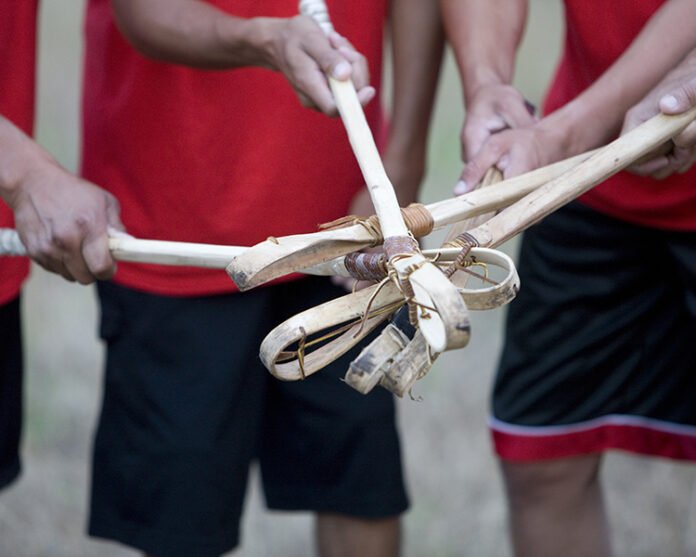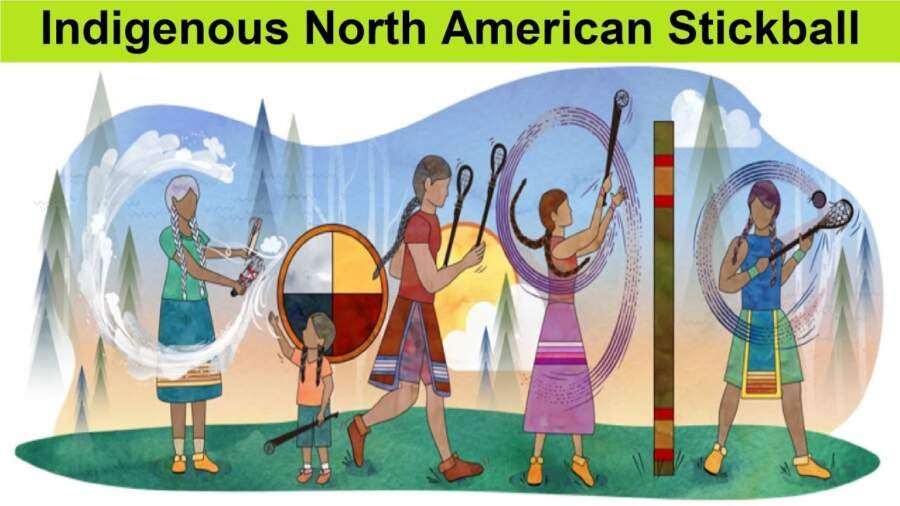Indigenous North American stickball, known as the “Brother of Wars,” is more than just a sport; it’s a tapestry woven with the threads of history, culture, and tradition. This ancient game has transcended time, providing insights into the lives and legacies of Native American communities. In this exploration, we will delve into the centuries-old history of stickball, its integral role in tribal warfare, the profound rituals that accompanied it, the intricate rules governing the game, and the symbolic significance of the sticks, balls, and other equipment used. Let’s embark on a journey to uncover the deep-rooted traditions and significance of Indigenous North American stickball.
History Of Indigenous Stickball
The history of Indigenous North American stickball is a tale of cultural heritage and ancient traditions that have endured for centuries. Dating back to pre-colonial times, stickball was more than just a game; it was a reflection of the interconnectedness of Native American communities. This sport, often referred to as the “Little Brother of War,” held immense importance in tribal societies.
It served as a means of conflict resolution, symbolizing honor, courage, and unity. The first recorded instances of stickball offer glimpses into the customs and values of Indigenous peoples, illustrating the game’s role in preserving their identity and heritage.
Stickball Role In War
Stickball, an ancient Indigenous North American sport, plays a profound role in tribal warfare and conflict resolution. Often termed the “Little Brother of War,” stickball served as a vital alternative to bloodier conflicts. It played a multifaceted role in the context of war.
In times of tribal disputes, stickball offered a unique avenue for conflict resolution. Rather than resorting to large-scale, destructive battles, tribes would engage in stickball games. These matches served as a means of asserting dominance and settling disputes without excessive bloodshed, providing an opportunity for tribes to preserve their populations and resources.
Stickball was also a training ground for warriors. The physical demands of the game, such as agility, speed, and coordination, sharpened the combat skills of those who participated. It prepared them for the rigors of actual warfare, creating a pool of physically fit and skilled individuals who could be called upon to defend their tribe.
Moreover, stickball was a platform for leadership development. As tribes formed teams and engaged in the game, leaders naturally emerged. These leaders would later play crucial roles in military operations, using the strategic thinking and decision-making skills honed on the stickball field to guide their tribes in times of conflict.
Symbolism was deeply ingrained in the sport, from the sticks used in the game to the rituals surrounding it. The sticks and balls had cultural significance, reinforcing the warrior ethos and inspiring unity and bravery among participants. The game itself was a manifestation of the tribal spirit, embodying the very essence of Indigenous North American communities, influencing both peaceful resolutions and their readiness for times of conflict.
Stickball Evaluation To Lacrosse
Comparing Indigenous North American stickball to lacrosse reveals intriguing similarities and distinctions. Both sports involve teams using long-handled sticks to move a ball towards a goal, emphasizing teamwork, strategy, and agility. However, differences arise in the details. Lacrosse, with its French and English influences, is often more structured and formal, with standardized rules.
In contrast, stickball is deeply rooted in Native American traditions and varies significantly among tribes, reflecting cultural diversity. Stickball places greater importance on the symbolic aspects of the game, incorporating rituals and ceremonies, while lacrosse focuses more on the competitive aspect. Despite these distinctions, both sports hold cultural significance and showcase the rich heritage of their respective communities.
Stickball First Recorded In History
The first recorded instances of Indigenous North American stickball, or the “Little Brother of War,” can be traced back to ancient times. While specific dates are elusive, historical accounts and artifacts suggest that this indigenous sport predates European contact.
Early Spanish explorers and colonists, such as Hernando de Soto, documented encounters with Native American tribes engaged in stickball in the 16th century. Indigenous stickball had already been an integral part of tribal cultures, serving various social, spiritual, and competitive purposes long before written records existed. These encounters with European settlers shed light on the existence of a deeply rooted and centuries-old tradition within Native American communities.
Indigenous North American Stickball Rituals
Indigenous North American stickball, beyond a game, was steeped in rituals deeply rooted in tribal cultures. The Ball Dance, a ceremonial performance, often preceded matches, invoking spiritual blessings for players’ safety and success. Shaman rituals involved spiritual guidance and protection, with shamans blessing the sticks and players.
Individual players had their pre-game rituals, invoking personal superstitions or seeking blessings. These rituals fostered a sense of unity and connectedness among tribal members and served to prepare players mentally and spiritually for the challenges of the game. Stickball rituals were not just a prelude to competition; they were an integral part of the cultural and spiritual fabric of Indigenous communities.
Ball Dance Rituals
Ball Dance, a central ritual in Indigenous North American stickball, was a profound ceremonial performance preceding matches. This dance held deep spiritual significance within tribal cultures. It involved intricate choreography, with dancers mimicking the movements of stickball players.
The dance was a communal event, often accompanied by traditional music and singing. Its primary purpose was to invoke blessings from the spiritual realm for the safety and success of the players. The rhythmic and symbolic nature of the Ball Dance created a sense of unity, connecting players and spectators to the spiritual essence of the game. It served as a vital link between the physical and the spiritual, reinforcing the cultural richness of stickball.
Shaman Rituals
Shaman rituals play a vital role in the world of Indigenous North American stickball, intertwining spirituality with the physical aspects of the game. Shamans, revered spiritual leaders, conducted these rituals before and during stickball matches. Their primary purpose was to seek guidance and protection from the spirit world.
Shamans often blessed the sticks used in the game, infusing them with protective and empowering energy. They also conducted cleansing ceremonies to purify the players and ensure their spiritual readiness for the game. During matches, shamans provide spiritual guidance and interpreted signs and omens, influencing strategic decisions.
These rituals created a profound connection between the game and the spiritual beliefs of indigenous communities. The presence of shamans infused the sport with a deeper, sacred dimension, reinforcing the idea that stickball was not just a physical competition but a spiritual endeavor deeply rooted in the culture and heritage of Native American tribes.
Player’s Rituals
Player’s rituals in Indigenous North American stickball were deeply personal and held cultural significance. Before a game, individual players often engaged in their pre-game rituals. These rituals could vary widely from one player to another and were based on personal beliefs, superstitions, or spiritual practices.
Some players sought blessings from elders or shamans, while others had unique routines to prepare mentally and spiritually. The rituals served to instill confidence, focus, and a sense of connection with the game. They also showcased the rich diversity of beliefs within Native American communities, emphasizing the importance of individual and collective spiritual connections to the sport. Stickball was not only a physical competition but a deeply spiritual and physical journey for its players.
Stickball Game Wager
Wagering in Indigenous North American stickball was a customary practice that added a layer of excitement and significance to the games. Before and during matches, various forms of bets were placed. These wagers were not limited to material possessions; they often involved highly valued items, livestock, or even personal adornments.
Wagering was more than a simple bet; it was a way for tribes to symbolically invest in the outcome of the game, reinforcing the sense of tribal identity and unity. Winning or losing these bets carried cultural weight, and the practice reflected the deep-rooted traditions and the importance of the sport within Indigenous communities. Wagering in stickball was a testament to the rich cultural tapestry surrounding the game.
Rules Of Indigenous North American Stickball Doodle
Stickball’s fundamental principles are rather straightforward: if the ball enters the goalpost post of the opposing team, you score a point. The object of the game is to score points by going. The fact that the game is played under different rules in different parts of the nation makes other rules and regulations quite ambiguous.
For instance, the rules for Chickasaw stickball and the Eastern Band of Cherokee Indians stickball differ from those of the Choctaw stickball. They claim that because the regulations vary from game to game, stickball is never the same.
On the other hand, all stickball games share a few fundamental guidelines. Watch this,
Team Players
In Indigenous North American stickball, team players were essential to the game’s dynamics. A typical team consisted of multiple players, often with designated roles. These roles included drivers, who played a crucial strategic role, as well as other positions that contributed to the team’s success. Teamwork was paramount in achieving victory.
#Drivers
Drivers were key figures in stickball teams, responsible for leading offensive plays and orchestrating strategies. They possessed exceptional skills in ball handling, agility, and speed, guiding the team towards scoring goals while outmaneuvering opportunities.
#Scoring
Scoring in stickball involved propelling the ball into the opposing team’s goal post using the sticks. Points were awarded for successful goals, with different point values for various types of goals, creating a nuanced scoring system.
#Timing
Stickball matches typically had a specific duration, often determined by various factors, including tribal customs and local traditions. The timing aspect added an element of urgency and strategy, influencing gameplay and team tactics.
Handling The Ball
The unique techniques for handling the ball in stickball required a blend of finesse and dexterity. Players used their sticks to carry, pass, and shoot the ball, showcasing their skill and teamwork.
Injury
While stickball was generally non-violent, it was physically demanding, and injuries could occur. Tribes had measures in place to ensure player safety, emphasizing respect for opponents and the preservation of the cultural tradition.
Other
Various other aspects of stickball, such as the dimensions of the playing field, the influence of weather conditions, and specific tribal customs, added depth and complexity to the game, making each match a unique cultural experience.
Stickball Sticks, Ball, And Other Equipment
Indigenous North American stickball was not only defined by its rules and rituals but also by the unique equipment used in the game. The sticks, balls, and other gear held cultural significance and contributed to the sport’s deep-rooted traditions.
Sticks were the primary tools in stickball, and they varied in design and materials used. The sticks were typically made of wood and consists of two main types: offensive and defensive sticks. Offensive sticks, also known as “slewes” or “goals,” were lightweight, curved, and often intricately decorated. These sticks were used to catch, carry, and shoot the ball into the opponent’s goal. Defensive sticks, on the other hand, were longer and heavier, providing players with the means to obstruct and defend against their opponents. Each stick was carefully crafted and sometimes adorned with tribal symbols, feathers, or other meaningful decorations.
The ball used in stickball was traditionally constructed from a round, wooden core covered with leather strips. These strips were typically sewn together with sinew, creating a resilient, compact sphere. The balls could vary in size and weight depending on regional and tribal customs, adding an extra layer of challenge and diversity to the game.
Apart from sticks and balls, players also wore protective gear, such as leather or woven reed leg guards to shield against accidental hits. Additionally, some players adorned themselves with ornamental and symbolic accessories, like headdresses or body paint, to honor their tribal heritage during the game.
The equipment in stickball was not just functional; it was laden with cultural symbolism. The decoration of sticks, choice of materials, and craftsmanship all represented the unique identity of each tribe. The game’s equipment play a vital role in unifying communities and showcasing their rich heritage. Stickball’s equipment was a testament to the significance of cultural identity within Native American societies, highlighting the sport’s role as a bridge between the past and the present.
Types Of Sticks In Indigenous Stickball
In Indigenous North American stickball, a fascinating array of stick types was employed, each with specific purposes and designs. These sticks were integral to the game’s dynamics and added depth to the sport’s rich cultural tapestry.
Offensive Sticks, often referred to as “slewes” or “goals,” served as the primary tools for scoring in stickball. These sticks were lighter and shorter, with a curved shape, allowing players to carry, pass, and shoot the ball into the opposing team’s goal with precision. Their design emphasized ball control, making them crucial for offensive players seeking to score.
On the defensive front, players utilized Defensive Sticks, which were longer and heavier. These sticks were specifically designed for obstructing the opponent’s offensive plays and protecting their own goal. The robust design of defensive sticks provided defenders with the strength and durability needed to fend off attackers and prevent goals, making them essential for the defensive aspect of the game.
Midfield Sticks, as the name suggests, were versatile tools that combined offensive and defensive capabilities. These sticks allowed players to transition seamlessly between their roles, adapting to the evolving needs of the game. This versatility made midfield sticks a valuable asset for players who needed to balance both offensive and defensive responsibilities.
Beyond these primary stick types, some tribes developed Specialized Sticks tailored to unique strategies or cultural significance. These specialized sticks could differ in shape, size, or purpose, aligning with specific preferences and customs within the tribe. These variations in stick types illustrated the depth of tribal diversity within Indigenous communities, showcasing the adaptability and evolution of the game while emphasizing the cultural richness surrounding the sport. Stickball’s sticks were not just tools; they were a reflection of cultural identity and added layers of meaning to each match.
Decoration Of Sticks
Decoration of sticks in Indigenous North American stickball held significant cultural importance. Sticks were more than just functional tools; they were intricately adorned with symbolic decorations. These decorations often included tribal symbols, feathers, or other meaningful elements that varied from tribe to tribe. The designs were not merely for aesthetics; they carried deep spiritual and cultural significance, reinforcing tribal identity and heritage.
The act of decorating the sticks was a ritual in itself, serving to connect players and spectators with their ancestral traditions. Each stick was a canvas representing the tribe’s unique identity, making it a powerful symbol of the game’s cultural richness and historical continuity.
Conclusion
Indigenous North American stickball, the “Little Brother of War,” is far more than a sport; it is a living testament to the deep-rooted traditions, spirituality, and cultural richness of Native American communities. Its history, rituals, and equipment reflect the multifaceted nature of this ancient game, which has endured for centuries.
The rituals and symbolism surrounding stickball, along with the unique equipment used, serve as poignant reminders of the profound connection between the game and the identity of Indigenous peoples. The legacy of stickball, steeped in tradition and unity, continues to thrive, preserving the heritage of Native American communities and showcasing the enduring importance of cultural diversity.
FAQs
Why Native Americans Play Stickball?
Native Americans play stickball to honor their cultural heritage, promote unity within their communities, and carry on traditions passed down through generations. The game holds deep cultural significance and spiritual importance.
Is Stickball A Violent Sport?
Stickball is not inherently violent. While it can be physically demanding, it is typically non-violent, serving as a means of settling disputes and fostering cooperation.
What Is The Oldest Stickball Game?
The precise origin of stickball is challenging to determine, but it is one of the oldest team sports in North America, with roots dating back centuries. It holds historical and cultural importance within Native American communities.
Read Also: Who is Mekayla Diehl? Her Wiki/Bio, Early Life, Net Worth and More




































































